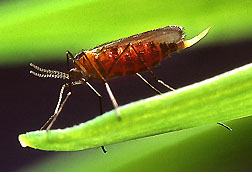Winter Wheat Gets New Resistance to Hessian Fly
|
|
The Southeast's warmer climate allows up to six generations of the Hessian fly to breed each season, and that spells trouble for soft red winter wheat growers.
The Hessian fly, Mayetiola destructor, is considered wheat's most damaging pest. In 1989, damage from the pest was estimated at $28 million in Georgia alone.
Plant breeders have been able to give wheat some natural resistance to the Hessian fly for many years. Now Agricultural Research Service entomologist Roger H. Ratcliffe in West Lafayette, Indiana, in cooperation with researchers at Purdue University, has developed and tested a new cultivar, a variety called Grant, and eight experimental wheat breeding lines—Carol, Erin, Flynn, Iris, Joy, Karen, Lola, and Molly—derived from Newton, a commercial hard red winter wheat susceptible to Hessian fly. All show improved resistance.
"Grant, a soft winter wheat, offers high yields, improved disease resistance, and better cold hardiness. It has been performance-tested in Indiana, Illinois, Missouri, and Ohio and in the Uniform Eastern Winter Wheat Nursery in West Lafayette," says Ratcliffe. "Grant's soft wheat milling and baking scores resemble those of Caldwell, one of the leading varieties grown in Indiana."
In 8 years of testing, Grant outyielded Caldwell by 4,630 pounds per acre. It also heads, or starts grain formation, 1 to 2 days later, has shorter, stronger straw, and is more likely to survive harsh Indiana winters, Ratcliffe says.
Besides leaf rust and powdery mildew, the new wheat variety resists wheat soilborne mosaic, wheat spindle streak mosaic, and take-all diseases. Infestation with Septoria leaf blotch and glume blotch was less severe on Grant than on Caldwell.
Ratcliffe says the eight breeding lines proved resistant to one or more of four Hessian fly biotypes in tests using seedling wheat plants. All the lines resemble Newton but can be up to 4 days later in heading and from 4 inches shorter to 2.5 inches taller.
The new lines have adequate winter hardiness for growing in field trials in many areas of the United States. The lines should prove useful for breeding Hessian fly-resistant cultivars or for genetic studies.
Wheat breeders will use this germplasm to develop improved wheat cultivars adapted to the eastern and southern states. Seed is now available from Purdue University and will be available in 1998 from the ARS National Small Grains Collection in Aberdeen, Idaho. — By Hank Becker, ARS.
Roger H. Ratcliffe was in the USDA-ARS Crop Production and Pest Control Research Unit, Purdue University, West Lafayette, IN 47907-1158.







